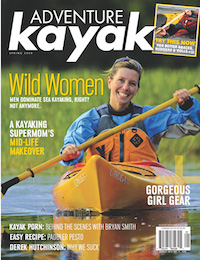In his letter to the editor in our Spring 2008 issue, John Dowd implies that the advanced skills of sea kayaking, namely rolling, and the British tradition of narrow high-performance kayaks with tight-fitting cockpits are a turnoff to the majority of paddlers—and to women in particular.
Our sport is defined by this hackneyed juxtaposition. In one corner you have British sea kayaking, personified by the legendary curmudgeon Derek Hutchinson and emphasizing narrow kayaks with skegs, small cockpits, short and wide-bladed paddles, rough water and Eskimo rolls that are so bombproof you can boast “there’s no such thing as a capsize.” And in the other corner you have the North American tradition championed by John Dowd—wide kayaks with rudders, plush cockpits, feathered blades, sheltered waters, soft skills and paddle-float rescues.
This founding myth as a way to define our sport is as arbitrary, clichéd and counterproductive as two-party politics. Our rich wonderful world of sea kayaking is at once both too complex and too small to survive bisection. It’s time to give the old schism a good sea-burial and admit that British and North American sea kayaking are different parts of the same elephant.
Sea kayaking is the only leisure activity I know whose media does much soul searching about scaring away participants by making it appear too difficult. Whether the subject is running, skiing, surfing or home decor—magazines always aim for rapport and accessibility, but also strive for inspiration and aspiration. They accomplish the latter by profiling the luminaries, the geniuses, and the dreamers; the risk takers, the pros and the Olympians.
Without the visceral understanding of kayaking’s potential to transport me beyond the ordinary bounds of what’s considered easy, comfortable and accessible—or even sane—I would never have picked up a paddle and bought a boat. I read magazines because they open up the world beyond my own experience, and then show me how to get there.
Which brings me to the issue of women. Regarding the assertion that the so-called British tradition of sea kayaking is in some way a bastion of ego or chauvinism that is a turnoff to the “gentler sex,” let these pages be evidence to the contrary.
“I’M HARD PRESSED TO THINK OF AS MANY IMPRESSIVE ACCOMPLISHMENTS BY MEN IN THE PAST YEAR.”
Coincidentally, over half the women profiled in our “Wild Women” feature have top-level certification from the British Canoe Union (BCU). One of them, Jen Kleck from San Diego, just became not the first American woman, but the first American of any gender, to achieve the highest coaching award. In the past year Freya Hoffmeister made the fastest circumnavigations of anyone, not just women, around both Iceland and New Zealand’s South Island. As I write this, both the Swede Barbro Lindman and filmmaker Justine Curgenven (who penned three of our women’s profiles while en route to New Zealand) are undertaking separate south Island circumnavigations. I’m hard-pressed to think of as many impressive accomplishments by men in the past year.
To showcase what these women are doing (most of them in narrow, British-style boats, note) is the opposite of a turnoff. “I think that increased media has helped to inspire more women to get out and try challenging things,” Justine Curgenven emailed in the days before setting off. “It’s all created a momentum and excitement which has inspired a lot of people to make their dreams a reality. I’ve been told a few times after I’ve given a talk (by men as well as women), ‘Well, you are quite normal really, so if you can do it then so can I’.”
Exactly.
In fact, women are dominating sea kayaking right now, and there is so much new gear coming out designed specifically for them that I’m rethinking a statement I originally disagreed with, from feature writer Wendy Killoran when I invited her to contribute to our women’s issue:
“I certainly hope that you will also feature a male paddler’s issue,” she said. “Otherwise, it would seem quite biased.”
She’s right. At this rate we’ll need to do a special issue just so we don’t alienate the men.




